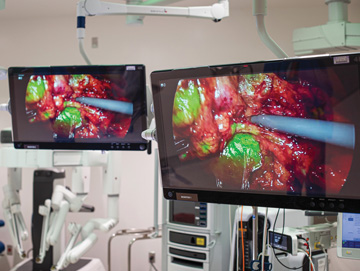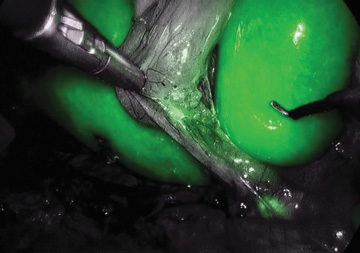Investing in 4K can be lucrative in other ways, too, according to Suraj S. Soudagar, MS, MBA, LEED AP, principal and project executive at IMEG Corp., a healthcare engineering firm in Naperville, Ill. He’s part of new build that will replace
two Mohawk Valley Health System (MVHS) hospitals in Utica, N.Y., a small city nestled between Syracuse to the west and Albany to the east. One of the hospitals is nearly 70 years old and the other has been around for more than a century.
“They don’t have modern air conditioning systems, let alone state-of-the-art imaging technology,” says Robert C. Scholefield, MS, RN, the health system’s executive vice president, whose sole job is overseeing the new hospital
project. The 670,000-square-foot main building is about 45% complete. Full construction is expected to be done by July 2023 and patients are scheduled to be relocated from the existing hospitals in October 2023.
The hospital will have larger ORs and brand-new equipment, including 4K video systems throughout. Leadership decided the imaging upgrade was needed after conferring with consultants and their frontline surgical teams. The consultants told them
4K technology would be needed to recruit top physicians to Utica. MVHS surgical staff noted that the current equipment was beginning to fail, experiencing problems with screens fogging and had an overall lack of image clarity.
MVHS is also building a surgery center on its campus in partnership with a private physicians group. Whether the ASC’s ORs will be outfitted with 4K is an open question, as the physicians must agree to adding the technology, but MVHS leadership
would like the facility to have the same video technology as the new state-of-the-art hospital, says Mr. Scholefield.
He says the health system’s surgical, interventional radiology, advanced endoscopy and cardiology personnel explained why they needed better imaging technology for better diagnoses.
“Our surgeons made the case that they needed 4K to navigate more precisely in smaller anatomical areas to be more precise and make better diagnoses,” says Mr. Scholefield. “We decided to make it available to them and, quite frankly,
they’re thrilled. They feared we would invest in a lesser technology.”
The leadership also realized that 4K would be necessary to get the best candidates in the system’s general surgery residency program, which will launch when the new hospital opens.
The choice to create a high-tech hospital had a significant multiplier effect. The project caught the attention of Las Vegas casino mogul Steve Wynn, a Utica native, who heard about the project, became curious, and was impressed with its high-tech
aspect. That led to a $50 million donation. The Wynn dollars aren’t being used for actual construction. Rather, they’re being allocated for programs to target and retain physicians. “Mr. Wynn was happy that we were building
a facility with high levels of technology and wanted to help recruit providers we might normally not be able to attract,” says Mr. Scholefield.
.svg?sfvrsn=be606e78_3)


.svg?sfvrsn=56b2f850_5)